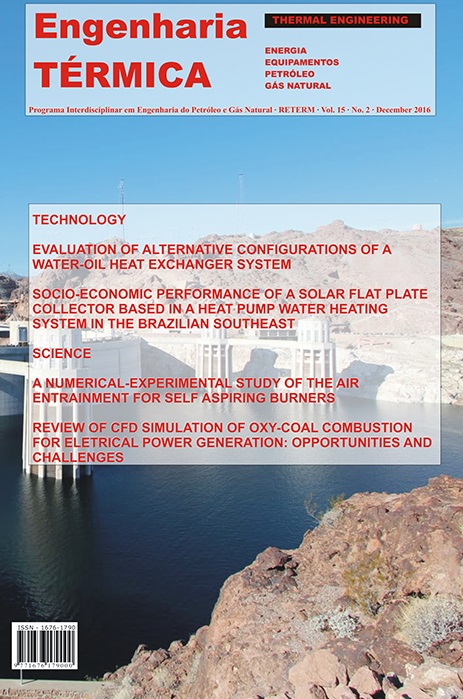GEOMETRICAL OPTIMIZATION OF MIXED CONVECTIVE FLOWS OVER TRIANGULAR ARRANGEMENT OF CYLINDERS
DOI:
https://doi.org/10.5380/reterm.v15i2.62180Keywords:
constructal design, arrange of cylinders, geometrical optimization, mixed convectionAbstract
The present study consists on the numerical evaluation of a triangular arrangement of circular cylinders submitted to transient, two-dimensional, incompressible, laminar and mixed convective flows. The geometrical evaluation is performed by means of Constructal Design. For all simulations it is considered Reynolds and Prandtl numbers of ReD = 100 and Pr = 0.71. Moreover, three different values of Richardson number are investigated: Ri = 0.1 (which represents flows dominated by forced convective), 1.0 (which represents an equilibrium between forced and natural driven forces) and 10.0 (which represents flows with dominance of natural convective). The conservation equations of mass, momentum and energy are solved with the use of Finite Volume Method (FVM). The buoyancy forces are tackled with the Boussinesq approximation. The area occupied by the triangular arrangement of cylinders is a geometric constraint of the problem and the cylinders have the same diameter. The main purpose is to evaluate the effect of Richardson number over the drag coefficient (CD) and Nusselt number (NuD) between the cylinders and the surrounding flow, as well as, over the optimal ratio ST/D (ratio between transversal pitch and the cylinder) for two different values of the ratio SL/D = 1.5 and 2.5 (ratio between longitudinal pitch and the cylinders diameter). Results showed that the effect of ST/D over drag coefficient and Nusselt number is strongly affected by the magnitude of Richardson number. Concerning the Nusselt number, for Ri = 0.1 the optimal geometry which maximizes the NuD is reached for the highest magnitude of ST/D, while for Ri = 10.0 an intermediate optimal ratio of ST/D maximizes the NuD. The Richardson magnitudes also have large influence over the fluid dynamic and thermal behavior of fluid flow for all evaluated geometries. An increase in the ratio SL/D improved the heat exchange of the flow, but decreased the fluid dynamic performance.
Downloads
Published
How to Cite
Issue
Section
License
Direitos Autorais para artigos publicados nesta revista são do autor, com direitos de primeira publicação para a revista. Em virtude da aparecerem nesta revista de acesso público, os artigos são de uso gratuito, com atribuições próprias, em aplicações educacionais e não-comerciais.



